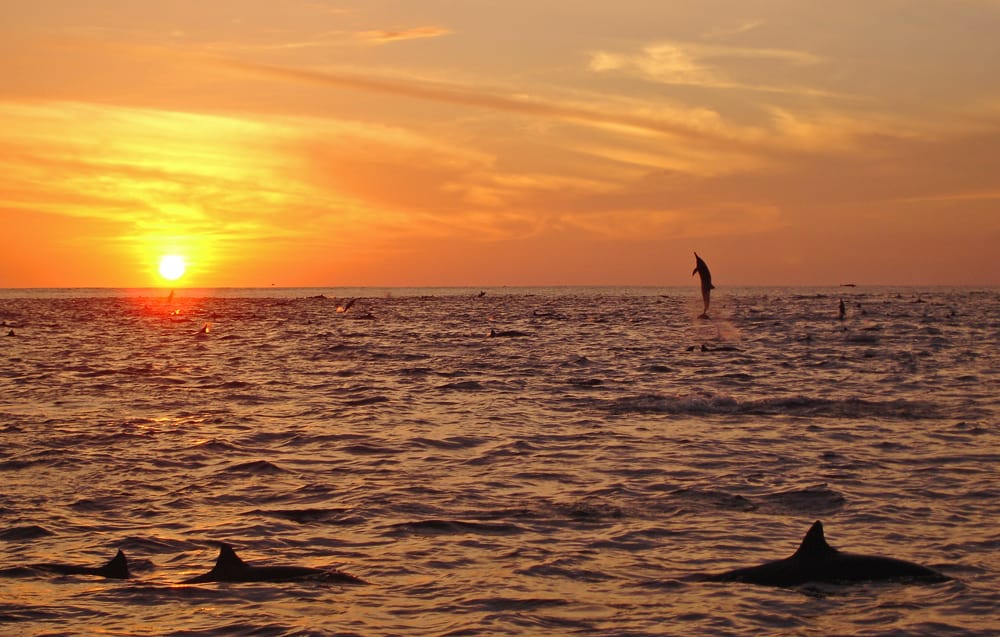The most productive garden in Costa Rica just got rid of a bunch of destructive bulldozers stealing the biggest fruits.
For decades, nets bigger than your house have plowed the Pacific for tuna, killing all sorts of denizens of the deep, including dolphins, when they are accidentally ensnared as bycatch. Starting a few weeks from now, the tuna dozers have been instructed to leave the area.
President Laura Chinchilla decreed that these mayhem machines should wreak their havoc more than 60 miles from our rich coast. She told the tuna ships they could do their thing 60-200 miles offshore. The tuna ships are still welcome by the government in most of Costa Rica’s Pacific, but it’s time to move on out.
The new regulations will protect some of the most bio-productive ecosystems in Costa Rica. Some of the largest known dolphin pods in the world (such as the spinner dolphin megapods featured in the BBC1 John Downer Productions Spy in the Pod series this year, will no longer be caught in nets during attempts to round up giant tuna that swim with them. The Pacific will likely bloom like never before.
The ocean’s productivity will hopefully respond quickly, with dolphin pods and tuna schools growing to numbers never seen before. The bounty will likely spread all the way to the beaches in a domino effect of recuperating ecosystems.
Since the area also covers the diverse seascape of the continental shelf drop-off, the reverberations will be good and deep. The fantastic world of undersea cliffs and canyons plunging from a couple hundred meters to a couple of thousand meters gives the open ocean waters above the greatest bio-productivity in the nation, rivaled only by the shifting Costa Rican area of the Central American Dome, which is much further offshore. Conserving apex predators out to 60 miles offshore will bring back other fish and interconnected life that nobody has even thought about.
While the world will be a better place when the slaughter brought on by tuna fleets is curtailed, it’s the international tourists, Central Valley pescado aficionados, and especially coastal communities that will benefit most. The newly enriched oceans will drive a swell of economic activity, and of course all that value will bring its own set of problems.
Enforcement of the ocean management plan will be a challenge. Corruption will cause setbacks. But the plan is a positive and decidedly blue adjustment. And there is reason to believe that advances in technology and organization will stop poachers in their wake.
The new radars being installed along the coast will light up the massive tuna ships and their helicopters on a screen at coast guard bases onshore. This is a big advance over current methods of driving around a small part of the ocean with a boat or a plane, hoping to find a tuna ship that does not detect the sting on its advanced radar. Tuna ships will also have to carry GPS locators. For the first time, the coast guard will have technology similar to the poachers. And drones patrols and satellite time for Costa Rican seas can’t be far behind, which will tip the scales.
Marine tourism and local fishers will continue to be vocal about poachers in the new area, but now they will have a lot more footing. Sixty miles is about as far as you can do on a day trip from shore, and much of that will be patrolled.
Several projects are in the works for private groups to patrol for poachers and report them. Dedicated groups helping with patrols for enforcement is the future of marine conservation. Groups like Sea Shepard, which is saving the whales of Antarctica, show that a difference can still be made even when governments won’t put up the money. Boats with cameras, laptops and media can make poachers disappear if the laws are in place.
The decree, which was pushed by fisherman Enrique Ramirez and FECOP, likely also received a boost from the BBC Natural History Units spectacular dolphin shows claiming the biggest dolphin pod they could find on the blue planet.
And we should not underestimate The Tico Times reporting on the topic since the 1990s. The first column I wrote in these pages calling out the tuna dozers was in 1998. But Laura Chinchilla made this happen, and it was probably quite a political challenge to get such entrenched, moneyed interests to give up the areas on the map the tuna fleet call Jackpot and Bonanza. No other single decree could have done so much for Costa Rican oceans as moving the tuna dozers far offshore, short of banning them totally. The blue jackpot and bonanza will now be for people and marine life instead of a foreign tuna fishing fleet.
Laura Chinchilla’s blue legacy will be that the fruits of Costa Rica’s marine garden will bloom. And perhaps the benefits will bloom most for the biggest resident dolphin pods in the world, along with the massive schools of giant tuna and other life that swim beneath them in the big blue of Costa Rica.






